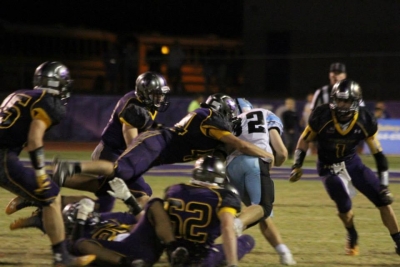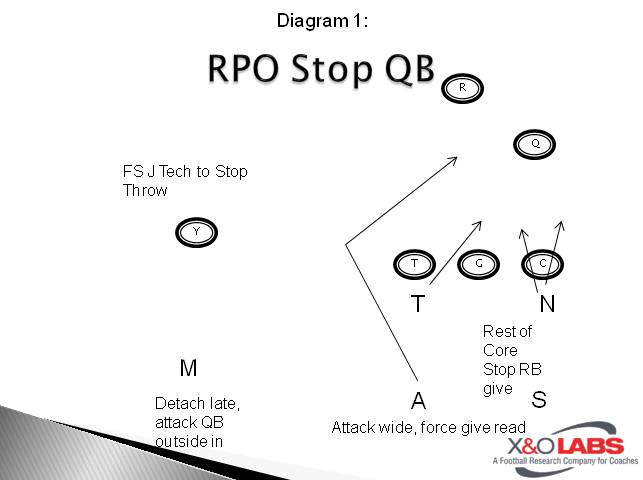By Ryan Desrochers
Defensive Coordinator/Linebackers Coach
Sunrise Mountain High School (AZ)
Twitter: @CoachRDes
Introduction:
 Everyone is scrambling to try and defend increasingly prevalent run pass option schemes. Some coaches feel that playing man coverage eliminates the pass option, but that leaves a good portion of your defense with their backs turned on the play. Other coaches play RPO’s as if they are a triple option play. While this approach assigns one defender to the RB, QB, and receiver, many offenses are looking to create one on one matchups with their athletes in space to exploit these exact situations. As a defense, we do not have a special scheme or call that we use to defend RPO’s, but rather choose what we want to eliminate and rally to the other options.
Everyone is scrambling to try and defend increasingly prevalent run pass option schemes. Some coaches feel that playing man coverage eliminates the pass option, but that leaves a good portion of your defense with their backs turned on the play. Other coaches play RPO’s as if they are a triple option play. While this approach assigns one defender to the RB, QB, and receiver, many offenses are looking to create one on one matchups with their athletes in space to exploit these exact situations. As a defense, we do not have a special scheme or call that we use to defend RPO’s, but rather choose what we want to eliminate and rally to the other options.
Overview of Defense
At Sunrise Mountain, we run a 3-3 Stack Defense. As a base, we usually will stunt the line and send one backer. However, against RPO teams, we will often stunt our line without sending a backer. This allows our linebackers to play football fast and use our speed to our advantage. We are a gap responsible defense, meaning that we let our linebackers be fast to the ball because we will have another backer or safety flowing behind them to assist on cutback. As a base rule for our defense, our A and B gap players are responsible for dive while our C gap players are responsible for QB and our dog safeties are responsible for pitchman. As we get into the season and gameplan for our opponents, we will adjust and tweak these assignments to help take away the best players on the other team.
Stopping a Dominant Running QB
Mobile quarterbacks can be very difficult to stop regardless of the scheme and RPOs tend to give them even more space to work. As a result, we double team the QB run and trust our other 6 defenders in the box to stop the running back and snap throw. We do this by giving a give read with our C gap defender and slow play the running back at the second level. By rule our C gap defender is a QB player on any option play.
We determine the type of option and run by how the RB lines up. If he is even with the QB, the C gap player opposite the RB will play the QB expecting a power read. If the running back is behind the QB, the C gap player to the RB side plays QB on the read option. Our C gap player will not take the air of the OT and instead play the inside shoulder of the QB. Our dog safety will slide in and attack the outside shoulder of the QB when he disengages from the mesh point and attacks. Our angles on the play cause the QB to bubble back, eliminating the throw due to lineman down field. There are times when he does complete the throw on the hitch and we live with 5 yards and a tackle. By our safety running the J technique into the box.

Coaching Points
- C Gap player (A) inside shoulder of QB
- B Gap Player (End) shock separate and look for RB
- M - late outside shoulder on QB detach
- Safety - J Technique to snap throw
When a QB is the team’s playmaker, we are going to do what we need to do to keep the ball out of his hands. Usually, they will get impatient and make a bad read and take tackles for losses.









